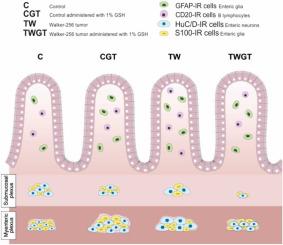当前位置:
X-MOL 学术
›
Acta Histochem.
›
论文详情
Our official English website, www.x-mol.net, welcomes your feedback! (Note: you will need to create a separate account there.)
Cancer-induced morphological changes in enteric glial cells in the jejunum of Walker-256 tumor-bearing rats
Acta Histochemica ( IF 2.5 ) Pub Date : 2024-02-28 , DOI: 10.1016/j.acthis.2024.152146 Fabiana Galvão da Motta Lima , Maysa Pacheco Alvarez da Silva , Sabrina Silva Sestak , Flávia Alessandra Guarnier , Ana Paula de Oliveira , João Victor Kuller , Brian David Gulbransen , Juliana Vanessa Colombo Martins Perles , Jacqueline Nelisis Zanoni
Acta Histochemica ( IF 2.5 ) Pub Date : 2024-02-28 , DOI: 10.1016/j.acthis.2024.152146 Fabiana Galvão da Motta Lima , Maysa Pacheco Alvarez da Silva , Sabrina Silva Sestak , Flávia Alessandra Guarnier , Ana Paula de Oliveira , João Victor Kuller , Brian David Gulbransen , Juliana Vanessa Colombo Martins Perles , Jacqueline Nelisis Zanoni

|
Cancer-induced cachexia is associated with systemic inflammation and gastrointestinal dysfunction. How changes to cells of the enteric nervous system contribute to gut dysfunction in tumor development and cancer cachexia is unknown. Here, we tested the hypothesis that changes to enteric glia, a type of peripheral glia that surround enteric neurons and regulate gut homeostasis, are associated with tumor development and that supplementing with the antioxidant L-glutathione is protective against the changes induced. Immunohistochemistry for neurons, enteric glial cells and immune cells was performed in whole-mount preparations and frozen histological sections of the jejunum from 20 Wistar rats, distributed in 4 groups: control, tumor of Walker-256, control administered with 1 % L-glutathione, and tumor of Walker-256 administered with 1 % L-glutathione. Morphoquantitative analyses were made using Image-Pro® Plus 4.5 and ImageJ® 1.43° software. Tumor development significantly reduced neuronal and glial cell populations in the myenteric and submucosal plexuses and enlarged glial cell body area in the submucosal plexus. In contrast, tumors increased glia in the jejunal mucosa and this effect was accompanied by B-lymphocyte recruitment. GSH-supplemented diet was not sufficient to protect against changes to neurons and glia in the submucosal plexus but was partially protective in the myenteric plexus. L-glutathione had no effect on physiological parameters of cachexia but was sufficient to preserve enteric glial cell density in the myenteric plexus. These results suggest that changes to both enteric neurons and glia likely contribute to the gastrointestinal effects of tumor development and that oxidative stress contributes to these effects in the enteric nervous system.
中文翻译:

癌症引起的 Walker-256 荷瘤大鼠空肠肠胶质细胞形态学变化
癌症引起的恶病质与全身炎症和胃肠功能障碍有关。肠神经系统细胞的变化如何导致肿瘤发展和癌症恶病质中的肠道功能障碍尚不清楚。在这里,我们测试了这样的假设:肠神经胶质细胞(一种围绕肠神经元并调节肠道稳态的外周神经胶质细胞)的变化与肿瘤的发展相关,并且补充抗氧化剂 L-谷胱甘肽可以防止所引起的变化。对 20 只 Wistar 大鼠的空肠整体制备物和冷冻组织切片进行神经元、肠神经胶质细胞和免疫细胞的免疫组织化学分析,分为 4 组:对照、Walker-256 肿瘤、给予 1% L-谷胱甘肽的对照,以及给予 1% L-谷胱甘肽的 Walker-256 肿瘤。使用 Image-Pro® Plus 4.5 和 ImageJ® 1.43° 软件进行形态定量分析。肿瘤的发展显着减少了肌间神经丛和粘膜下神经丛中的神经元和神经胶质细胞群,并且粘膜下神经丛中的神经胶质细胞体面积增大。相反,肿瘤增加了空肠粘膜中的神经胶质细胞,并且这种效应伴随着 B 淋巴细胞的募集。补充谷胱甘肽的饮食不足以防止粘膜下神经丛中神经元和神经胶质细胞的变化,但对肌间神经丛有部分保护作用。 L-谷胱甘肽对恶病质的生理参数没有影响,但足以保持肌间神经丛中的肠神经胶质细胞密度。这些结果表明,肠神经元和神经胶质细胞的变化可能导致肿瘤发展的胃肠道效应,并且氧化应激导致肠神经系统中的这些效应。
更新日期:2024-02-28
中文翻译:

癌症引起的 Walker-256 荷瘤大鼠空肠肠胶质细胞形态学变化
癌症引起的恶病质与全身炎症和胃肠功能障碍有关。肠神经系统细胞的变化如何导致肿瘤发展和癌症恶病质中的肠道功能障碍尚不清楚。在这里,我们测试了这样的假设:肠神经胶质细胞(一种围绕肠神经元并调节肠道稳态的外周神经胶质细胞)的变化与肿瘤的发展相关,并且补充抗氧化剂 L-谷胱甘肽可以防止所引起的变化。对 20 只 Wistar 大鼠的空肠整体制备物和冷冻组织切片进行神经元、肠神经胶质细胞和免疫细胞的免疫组织化学分析,分为 4 组:对照、Walker-256 肿瘤、给予 1% L-谷胱甘肽的对照,以及给予 1% L-谷胱甘肽的 Walker-256 肿瘤。使用 Image-Pro® Plus 4.5 和 ImageJ® 1.43° 软件进行形态定量分析。肿瘤的发展显着减少了肌间神经丛和粘膜下神经丛中的神经元和神经胶质细胞群,并且粘膜下神经丛中的神经胶质细胞体面积增大。相反,肿瘤增加了空肠粘膜中的神经胶质细胞,并且这种效应伴随着 B 淋巴细胞的募集。补充谷胱甘肽的饮食不足以防止粘膜下神经丛中神经元和神经胶质细胞的变化,但对肌间神经丛有部分保护作用。 L-谷胱甘肽对恶病质的生理参数没有影响,但足以保持肌间神经丛中的肠神经胶质细胞密度。这些结果表明,肠神经元和神经胶质细胞的变化可能导致肿瘤发展的胃肠道效应,并且氧化应激导致肠神经系统中的这些效应。



























 京公网安备 11010802027423号
京公网安备 11010802027423号